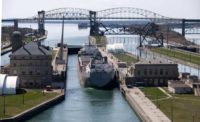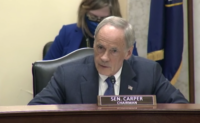The U.S. Army Corps of Engineers is using its expertise and a decentralized, rapid-response approach to establish dozens of field hospitals to meet an accelerating need for more beds to help manage the COVID-19 crisis.
For ENR’s latest coverage of the impacts of the COVID-19 pandemic, click here
Lt. Gen. Todd T. Semonite, Corps chief engineer and commanding general, told ENR that the agency has reached out to the governors of all 50 states about their needs for emergency hospital space. Semonite said work will be let through regular contracting vehicles and under normal Federal Emergency Management Agency regulations. By March 31, the Corps had received more than 500 requests for assessments, completed more than 400, awarded eight contracts—including four facilities for COVID patients and four for non-COVID patients—and had eight contracts pending.
“I’ve got planning teams today embedded into state capitals to be able to help the governors and the mayors determine what’s the best application,” Semonite said March 27, explaining that the Corps is working for FEMA through its regional directors as well as with the regional directors for the U.S. Dept. of Health and Human Services. Semonite spoke at the Jacob K. Javits Convention Center in New York City, where the first 1,000 beds for a field hospital being built there opened on March 31 to handle non-COVID-19 patients to relieve other hospitals.
The program was announced at a March 20 press briefing at the Pentagon.
“We knew we had only a matter of weeks in most of these cities, so we came up with standard designs that put in the medical parameters around whether the use would be COVID or non-COVID,” Semonite said. The plan also taps unused dorms, hotels, field houses and hospitals: “They all have electricity, they meet fire codes, they have parking lots, they have water and they even have staff that can help support this activity. “
Col. Thomas D. Asbery, commander and district engineer for the Corps’ New York district, said, for example, that Javits Center staff handles more than 175 events a year that are set up and torn down using a long list of contractors and laborers. “Alan Steel, Javits president and CEO, has a readily available work force whether it’s for a car show, or in this case, a hospital,” Asbery said. The engineered task here, he adds, focused on the layout, but elsewhere it could involve more construction work.
In a press conference, New York Gov. Andrew Cuomo announced his request to the Corps and the National Guard for temporary hospitals at four additional sites in New York City in addition to an original four, which included Javits. The new sites are the New York Expo Center in The Bronx, Aqueduct Racetrack in Queens, Brooklyn Cruise Terminal and the College of Staten Island. The state also seeks new sites in counties near the city. It will also clean and retrofit dorms and hotels.
For the hotel renovations, the Corps plans to use almost all the existing materials from furniture to HVAC. “if the state wants to make that a COVID room, we believe the majority of a hotel HVAC system can be used,” to create negative pressure, Semonite said. Workers will seal rooms with baffles on the doors and make some electrical modifications.
Corps Projects Nationwide
The Corps is “doing $66 billion worth of work for America now,” Semonite says. Work includes U.S. Department of Defense projects and $20 billion worth of civil works projects, including a “massive Veteran’s Administration program,” he said.
Projects have been separated into non-mission-essential and mission essential, where “we’re going to continue to make them happen,” he added, pointing to VA hospitals and national security-related DOD work. Semonite said there are projects where we can “slow down a little bit.” On these, the district commanders have the authority to decide the pace that is appropriate and non-mission-critical work also will follow state and local protocols for construction.
“There’s no simple one size fits all,” he added.
Decentralized Approach
At a webinar hosted by the Associated General Contractors of America, Christine Altendorf, chief of engineering and construction for the Corps, noted that coronavirus response is different from other disasters and emergencies the agency has faced such as hurricanes, storms or floods. The COVID-19 crisis is so widespread that it requires a broad geographic response. As a result, Altendorf said the Corps wants to “power down” to its district offices. “The focus is on speed,” she said. In some locations, the Corps will take the lead on contracting; in other places states and localities will take the lead.
Col. Robert Miceli, deputy director of the Corps contracting office, added, “Everything is being decentralized to the lowest level of execution.” The idea is to “maximize local responsiveness” and to avoid a big bureaucracy with signoffs needed from headquarters.
Albert “Chip” Marin, programs director at the U.S. Army Engineering and Support Center in Huntsville, Ala., said that in looking for the new hospital sites, officials want facilites within 10 miles or a 30-minutes drive from existing hospitals (including non-DOD and private hospitals).
They also want to use buildings that are state-owned and those that were built after about 1990, because older buildings might need asbestos or lead remediation.
This story was changed on April 2 to update statistics on the Corps' involvement.














Post a comment to this article
Report Abusive Comment